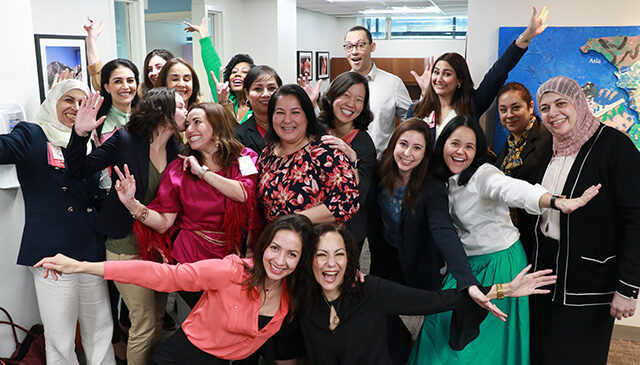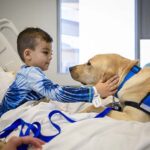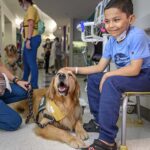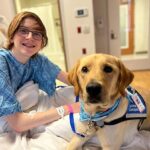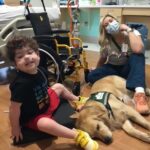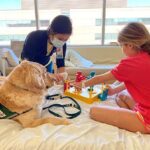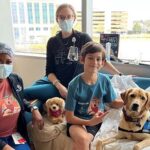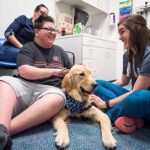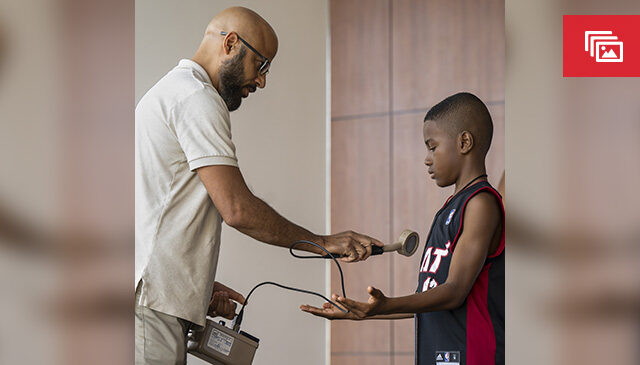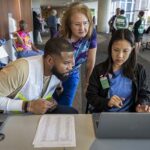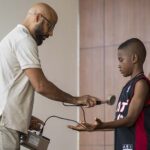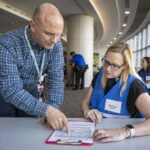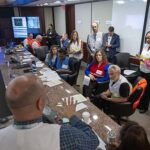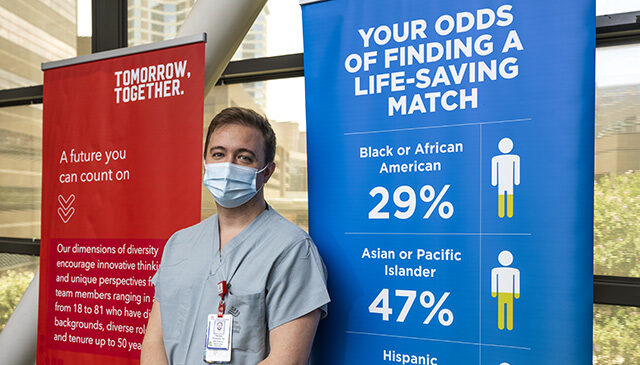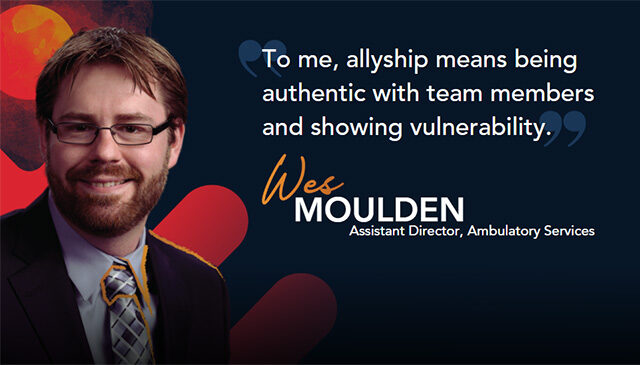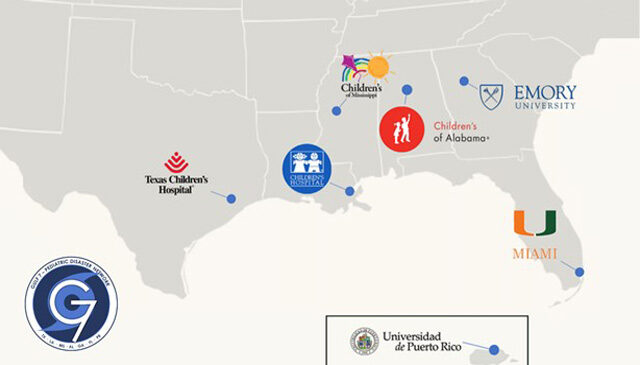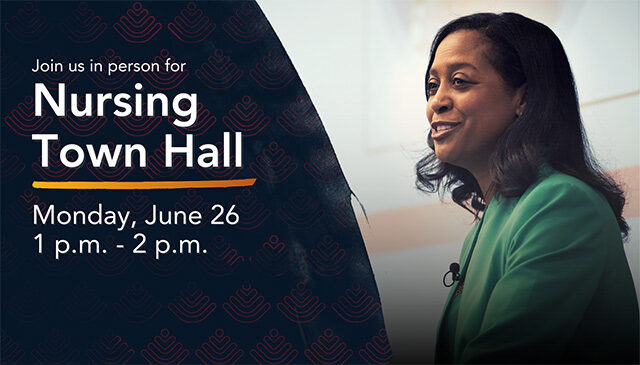July 5, 2023
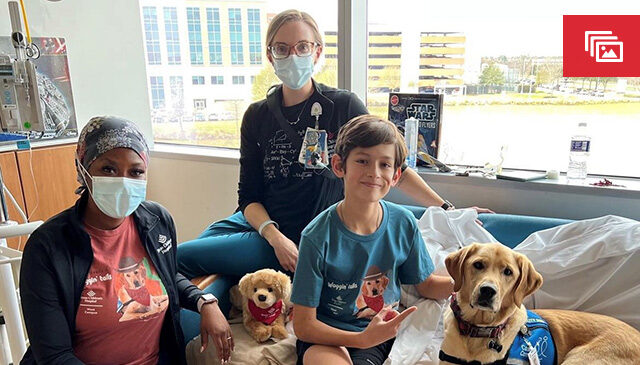
We have five facility dogs in our Pawsitive Play program – Angus, Bailey, Cohen, Pinto and Pluto. You may have seen their smiling faces around our campuses. They’re often referred to as therapy dogs, which are different. Texas Children’s actually has a group of volunteer therapy dogs who visit patients every other week and are trained to be friendly and provide comfort to all types of people through physical and emotional affection.
Our facility dogs are trained to provide goal-oriented therapeutic interventions and emotional support for hospitalized children as well as their families and our staff, and they are full-time employees of the hospital.
They each have an animal assisted therapy coordinator or more informally, a facility dog handler. You may have seen their smiling faces as well. If you want to learn more about the roles of the dog handlers, please click here for our recent story on Connect. Together, they work as a team providing patient care.
When it comes to the specific duties each dog performs, overall, the handlers determine the areas that would benefit most from having a facility dog present. Patient population, consults and events happening all factor into what jobs each dog will do, but most importantly, each facility dog’s behavior, size, personality, temperament and skills help the handlers assess where to assign them.
PLUTO
“Pluto was chosen to work in the outpatient clinics because he is very social and curious. He loves walking up to new people in the hallways and exploring new rooms, which is perfect because we meet new people every day in the different clinics we cover,” said Hanna Kuhn, Pluto’s handler. “He is also our biggest dog which makes him easy for patients to reach from their exam bed, so he is able to provide support while they pet him during their procedures.”
As an example of his support during outpatient procedures, during botox injections in the physical medicine and rehabilitation (PM&R) clinic, Hanna will place a chair next to the exam bed and ask Pluto to climb up and sit next to the patient. During the procedure, she provides developmentally appropriate information and support while encouraging the patient to pet Pluto during their injection or play with his toys between pokes. This is a good distraction while they focus their attention on Pluto instead of the procedure. At the end of their injections, Pluto will hop off the chair and they can re-engage in petting him and pick out which Pluto sticker they want to take with them.
ANGUS
Meg Gustafson works with Angus at West Campus. They provide coping support at the bedside and often co-treat with physical therapy. They seek out patients who need to ambulate and are either too scared or simply just don’t want to get out of bed.
Angus walks alongside the patient, or they can use a special leash so they can physically walk him around the hospital, and he will adjust his pace accordingly. This gives patients the confidence and encouragement to move knowing Angus is beside them.
When co-treating with physical therapy, he can play fetch with a patient who is working on their fine and gross motor skills. It doesn’t feel like work to them, but it gives the physical therapist a good indication of progress.
Other times, Angus does the work the patient is doing – when they stand, he stands and when they sit, he sits. When working on reaching and balance, Meg positions Angus an appropriate distance from the patient, and they have to reach over to pet him. Angus also helps normalize the hospital environment – he knows how to play Kerplunk and hide-n-seek, does a reading hour in the library on Wednesdays, and loves time in the playroom with his friends.
PINTO
Shelby Bonnet is Pinto’s handler. They focus on acute care and provide a lot of coping support at the bedside and co-treat with physical and occupational therapy, especially in the inpatient rehab unit. One of the things Pinto does really well based on his training is reading the needs of his patients and adjusting his energy level accordingly.
They often go on walks around the unit to encourage patients to ambulate after surgery. Patients are often cautious to move after surgery and take it slowly, but having Pinto next to them provides confidence and encouragement to take the next steps. Pinto does a great job of adjusting his speed so he is not pulling the patient while they are working on their balance.
Pinto also demonstrates patience when they work on fine and gross motor skills by using a brush to practice brushing his fur. Pinto lays on their bed while his patients are meeting their occupational therapy goals. On the other hand, Pinto is our most loyal fetch player and loves to chase after a ball thrown by a patient when it is more appropriate for him to show his energetic side.
BAILEY
Adair Winget and her dog Bailey work in the PICU and the Heart Center with our most critical patients. Bailey was chosen to work in this environment because of her small size and energy level. One of our sleepiest and snuggliest dogs. Bailey’s energy level is a perfect match for patients who are critically ill and able to pet her gently while she is snuggled next to them in their beds.
Once Adair gets her in place, Bailey will stay sleeping next to her patient for as long as they need. These attributes also allow her to lay safely next to her patients who have multiple lines, chest tubes, catheters, drains, etc. without risk of pulling them out since she will stay still in the bed.
Bailey also comforts patients in palliative care and provides therapeutic and emotional support at end of life. She is able to snuggle with them and take on their emotional burden, which allows them to die peacefully, knowing their friend was with them. Her colleagues agree Adair does a great job of supporting patients in these situations as well as taking care of Bailey to support her recovery so she is able to continue giving her energy to all her patients.
COHEN
CJ Canlas and her dog Cohen work at The Woodlands campus primarily in outpatient therapy, inpatient units (acute care and PICU) and outpatient clinics. CJ loves using Cohen to help support patients in meeting the goals of their care plan, which can vary from day to day.
Cohen can help motivate patients to walk after surgery or provide a supportive presence after a patient receives a new diagnosis. CJ also collaborates with her therapy team to think of creative ways to support their patients’ goals. In physical therapy, he engages the patient during their exercises, in speech therapy, he provides a non-judgmental presence while patients practice their sounds and read to him, and in occupational therapy, he supports sensory regulation and modeling tasks when the patients practice brushing his hair. They also collaborate with our occupational therapy team to give Cohen a role in feeding therapy – this is where Cohen shines!
These dogs have important jobs to do and make a real impact on our patients. Next time you run into one of our handlers and their facility dogs, please ask the handler first if it’s okay for you to interact with the dog, understanding they may be wiped out from patient interactions and need to recharge. Any interaction, even just to stop and say hi, takes energy. They love to greet everyone they meet, but need to make sure they conserve the majority of their energy for patients.
